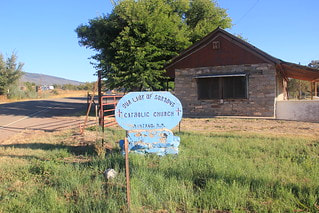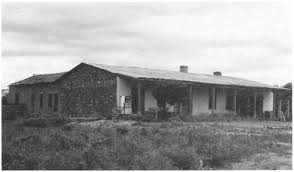
Last spring I gave a lecture at the Bear Canyon Senior Center on Civil War battles in New Mexico. Afterwards, one woman in the audience raised her hand and told me that her great-great grandfather had been a chaplain for the Union Army at the Battle of Glorieta. When I asked her if she was Polish, she smiled, knowing that I knew who she was talking about.
Alexander Grzelachowski was born in 1824 in Gracina, Poland. The son of a Polish Officer in the Napoleonic Wars, he became a Catholic priest, then emigrated to the United States in 1847. He served in Ohio until 1851, when he accompanied Jean Baptiste Lamy, the principle figure in Willa Cather’s novel Death Comes to the Archbishop, to New Mexico. He served several parishes, including Manzano’s Our Lady of Sorrows. Grzelachowski spoke fluent Spanish, and his parishioners called him Padre Polaco, the Polish Father.
Alexander Grzelachowski was born in 1824 in Gracina, Poland. The son of a Polish Officer in the Napoleonic Wars, he became a Catholic priest, then emigrated to the United States in 1847. He served in Ohio until 1851, when he accompanied Jean Baptiste Lamy, the principle figure in Willa Cather’s novel Death Comes to the Archbishop, to New Mexico. He served several parishes, including Manzano’s Our Lady of Sorrows. Grzelachowski spoke fluent Spanish, and his parishioners called him Padre Polaco, the Polish Father.

Grzelachowski left the priesthood in 1857 to open a mercantile business in Las Vegas, but when the Civil War broke out, he felt compelled to reenter the priesthood in order to serve his adopted country. He became the 2nd New Mexico Volunteers’ chaplain, and played a critical role in the Battle of Glorieta Pass.
Late on the night of March 28, 1862, Major John Chivington and his men became lost in a snowstorm in the treacherous and uncharted terrain atop Glorieta Mesa. Chivington had set out that morning with orders to drop down on the Confederate rear, so that his 400 men and Colonel John Slough’s 800 men could trap Colonel Scurry’s 1,300 Confederate troops between them. Instead, Chivington and his men had strayed off course, gone too far, and found themselves staring down at Johnson’s Ranch, where the Confederates had left their supply train under a light guard. Chivington had destroyed that train, an act that forced the Confederates to retreat to Texas, securing New Mexico for the Union.
Late on the night of March 28, 1862, Major John Chivington and his men became lost in a snowstorm in the treacherous and uncharted terrain atop Glorieta Mesa. Chivington had set out that morning with orders to drop down on the Confederate rear, so that his 400 men and Colonel John Slough’s 800 men could trap Colonel Scurry’s 1,300 Confederate troops between them. Instead, Chivington and his men had strayed off course, gone too far, and found themselves staring down at Johnson’s Ranch, where the Confederates had left their supply train under a light guard. Chivington had destroyed that train, an act that forced the Confederates to retreat to Texas, securing New Mexico for the Union.
 Grzelachowski's store in Puerto de Luna
Grzelachowski's store in Puerto de LunaBy nightfall, Chivington’s men were struggling back over Glorieta Mesa. What little intelligence they received suggested that Slough’s inferior numbers had failed to hold the field. The men atop the mesa had no idea where they could descend without encountering enemy troops. The night was dark and stormy, and snow fell heavily. Suddenly, an apparition appeared out of the gloom. It was an imposingly large man on a horse so white that it appeared to glow. Many soldiers thought an angel had appeared in their midst. That angel turned out to be Alexander Grzelachowski, who led the men safely around the Confederate troops and reunited them with Colonel Slough’s men. It was not an easy job. In fact, it was so difficult that Grzelachowski’s horse collapsed and died as he led the men into camp. But without the Father, it might have been Chivington’s troops who died by blundering into an enemy camp or succumbing to the elements.
After the war, Grzelachowski returned to private life. He started a family in 1870, marrying Secundina C. de Baca, with whom he fathered at least two daughters, Emma and Adelina. By 1872, the family had moved to Puerto de Luna, a little town on the bank of the Pecos River, about nine miles south of Santa Rosa. Here he opened a mercantile store similar to the one he operated in Las Vegas. He also ran a ranch, raised sheep, cattle and horses, and maintained a large orchard and vineyard.
After the war, Grzelachowski returned to private life. He started a family in 1870, marrying Secundina C. de Baca, with whom he fathered at least two daughters, Emma and Adelina. By 1872, the family had moved to Puerto de Luna, a little town on the bank of the Pecos River, about nine miles south of Santa Rosa. Here he opened a mercantile store similar to the one he operated in Las Vegas. He also ran a ranch, raised sheep, cattle and horses, and maintained a large orchard and vineyard.

Alexander Grzelachowski’s life intersected with many of New Mexico’s most famous and infamous citizens. Even though William Bonney, the young outlaw commonly known as Billy the Kid, reputedly rustled horses from one of his ranches, Grzelachowski seemed to have liked the young outlaw. He instructed his store clerks to allow Billy to take whatever supplies he needed. Bonney attended dances hosted by Grzelachowski, and on December 25, 1880, when Lincoln county Sheriff Pat Garrett and his posse was taking Bonney to jail in Las Vegas, the whole group stopped in Puerto de Luna, where Grzelachowski served Billy wild turkey and all the fixings for his last Christmas dinner.
Grzelachowski continued to be active in civil affairs throughout his life. He was the postmaster for Puerto de Luna, operating the post office out of his mercantile store. He also used the store as his chambers while he served as San Miguel county’s justice of the peace. After he helped lobby the territorial legislature for the creation of Guadalupe county from the southern part of San Miguel county in 1893, he served as the new county's first probate judge. Three new commissioners for Guadalupe county were sworn into office in his store.
In 1896, when he was 72 years old, the man often called Don Alejandro was thrown from a wagon while riding to his Alamogordo ranch. He is buried in the Nuestra Senora De Los Dolores Cemetery outside of Milagro, a small town in Guadalupe county.
Grzelachowski continued to be active in civil affairs throughout his life. He was the postmaster for Puerto de Luna, operating the post office out of his mercantile store. He also used the store as his chambers while he served as San Miguel county’s justice of the peace. After he helped lobby the territorial legislature for the creation of Guadalupe county from the southern part of San Miguel county in 1893, he served as the new county's first probate judge. Three new commissioners for Guadalupe county were sworn into office in his store.
In 1896, when he was 72 years old, the man often called Don Alejandro was thrown from a wagon while riding to his Alamogordo ranch. He is buried in the Nuestra Senora De Los Dolores Cemetery outside of Milagro, a small town in Guadalupe county.

Jennifer Bohnhoff is a native New Mexican who has learned about many interesting New Mexicans while researching her two Civil War novels, Where Duty Calls (published in 2022) and The Worst Enemy (to be published in August 2023.) Book Three, The Famished Country, will be published in 2024.
She wishes to thank Bernadette Flores for sharing pictures and stories of her illustrious ancestor, who will have a small role in her upcoming book.
She wishes to thank Bernadette Flores for sharing pictures and stories of her illustrious ancestor, who will have a small role in her upcoming book.





No comments:
Post a Comment